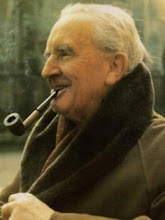As has been told, Morgoth escaped Ungoliant with the aid of the Balrogs, and when they had pursued her into the Mountains of Shadow, he recalled them. Together they returned to Angband, and Morgoth set up his seat in the fastness of Hell, reared the threefold reeking peaks of Thangorodrim above his doors, and wrought for himself a great Iron Crown, in which he set the three Silmarils. He proclaimed himself King of the World, and all evil things crept back to him from far and wide - a reversal (in a certain sense) of Aristotle's metaphysical notions of love and order, the chief concerns of the Demiurge; the idea that the Dark Lord threw forth his hatred and monstrous influence, and called it back to himself.
When Fëanor burned the Telerin ships at Losgar, the eyes of the servants of Morgoth were watching, and message came swiftly to him in Angband of all that was done, and Morgoth desired to drive them back into the sea. Now the Noldor marched east and north through Hithlum (not so-called yet) and came to Lake Mithrim, and there set their encampment by the shores of the lake. But on a sudden, the hosts of Morgoth's Orcs came upon them at unawares, ere their camp was full-wrought, but the Noldor were swift in their counter, and there in Mithrim was fought the Second Battle of the Wars of Beleriand, Dagor-nuin-Giliath, the Battle-under-Stars (for the Sun and Moon had not yet arisen). The hosts of the Noldor drove the Orcs back over the Mountains of Shadow with great slaughter, and they were pursued over Ard-galen. But another host of Orcs, the Orcs sent by Morgoth to lay siege to Círdan at the Havens, came hastening from the Vales of Sirion, and they pursued the Noldor from the south. But they were no match for the Elves, for Celegorm, son of Fëanor, came to the aid of his father with a host and drove the Orcs into the Fen of Serech. Evil indeed were the tidings that eventually came to Angband, and Morgoth was in doubt.
But Fëanor would not hault, and he pursued the remnant of the Orcs, thinking in the impetuosity of his wrath so as to come at Morgoth himself. And he was fey, and the joy of battle was upon him; for he had dared the wrath of the Valar, the perils of the Sea and he thought that he would see soon the hour of his vengeance. Fëanor knew nothing at all of Angband, nor that his unaided war upon Morgoth was without final hope, and coming into the very realm of Morgoth, Dor Daedeloth, he was overcome by Balrogs. Still he faught on, undismayed, and he was burned and wounded with many wounds; but Gothmog, Lord of Balrogs, was come, and cast the Elven-king down, and would have slew him, but the Sons of Fëanor came up in that moment with a host, and the Balrogs retreated to Angband.
The Sons of Fëanor then lifted up the body of their proud father, and they retreated to Eithel Sirion, the spring of the greatest river of Beleriand, and there he bade them set him down. With the eyes of Death, Fëanor looked towards Angband, and he saw afar the great peaks of Thangorodrim, and he knew then that the Noldor would never overcome the Dark Lord; but he cursed Morgoth three times, and charged his sons to keep to their oath, and so he died. But he had neither burial, nor tomb, for as his soul left his body, and went to Mandos* his body fell to ashes, and was blown away on a cold wind.
* This is an interesting point, which I shall address in the next post.
Friday, 24 July 2009
Subscribe to:
Post Comments (Atom)

I have been enjoying your summary of the Silmarilion. I have just started reading it (many years after reading LOTR) and have been enjoying greatly. It gives such depth to the books, and the world created by Tolkien. One question: Are you aware of a map showing Morgoth's realm? It is in the north here, but in the LOTR Sauron is in the south east. Is this a case of Middle-Earth global warming?
ReplyDeleteJim, there are two maps that I am aware of that show Angband, and the greater regions of Dor Daedeloth and the Ered Engrin. The first (drafted by Tolkien himself) is found in The History of Middle-earth Volume IV The Shaping of Middle-earth. Also in this volume are some interesting depictions of the earliest World maps, found in the Ambarkanta. Another one can be found on The Encyclopedia of Arda (there is a link in the side-bar) under Angband - although the map is somewhat conjuctural.
ReplyDeleteAs regards Morgoth and Sauron. Morgoth dwelt in the far north of Middle-earth (the North is traditionally the seat of the dark power - this is even found in the Bible, which is why the Deacon chants the Gospel facing the North) because when he returned to Middle-earth (in ancient days), the Valar were not there vigilant, and it was colder and somewhat darker; and there he delved Utumno. Since he was overthrown, and Sauron refused to return into the West to abide the judgement of the Valar, he had to find another stronghold - far removed from the West, the Elves, and the sea-power of Númenor. Kind of ''geographical necessity'' - although it greatly suited his purposes, because of Mount Doom (which he used much in his sorceries) and because of the natural mountain wall that fenced his land. Also, he had great influence over the heathen men of the Harad and East, who worshipped him as a god.
I don't know what you mean by ''global warming,'' (Tolkien would certainly have repudiated such reading of his story - as he did of correlations made between Sauron/Stalin, Orcs/Communists etc; but I hope this answers your question.